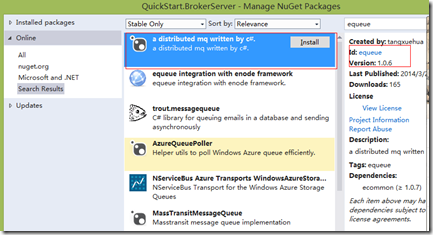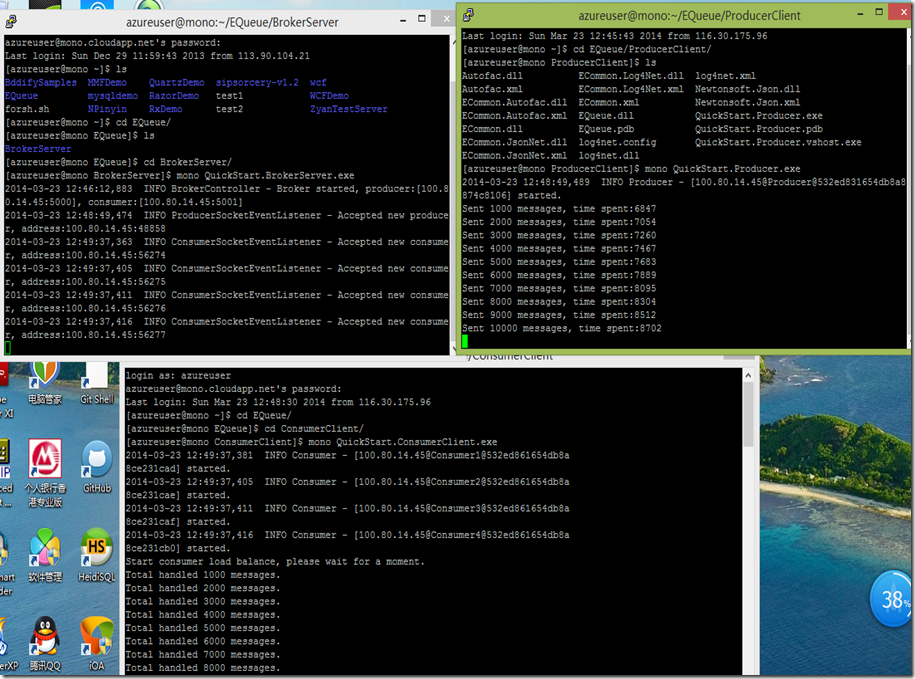一、简介
EQueue是一个参照RocketMQ实现的开源消息队列中间件,兼容Mono,具体可以参看作者的文章《分享一个c#写的开源分布式消息队列equeue》。项目开源地址:https://github.com/tangxuehua/equeue,项目中包含了队列的全部源代码以及如何使用的示例。
二、安装EQueue
Producer、Consumer、Broker支持分布式部署,安装EQueue需要.NET 4, Visual Studio 2010/2012/2013. 目前EQueue是个类库,需要自己实现Broker的宿主,可以参照QuickStart,创建一个QuickStart.BrokerServer项目,通过Visual Studio的Nuget 查找equeue
using System; using System.Text; using ECommon.Autofac; using ECommon.Configurations; using ECommon.JsonNet; using ECommon.Log4Net; using EQueue.Broker; using EQueue.Configurations; using EQueue.Protocols; namespace QuickStart.BrokerServer { class Program { static void Main(string[] args) { InitializeEQueue(); var setting = new BrokerSetting(); setting.NotifyWhenMessageArrived = false; setting.DeleteMessageInterval = 1000; new BrokerController(setting).Initialize().Start(); Console.ReadLine(); } static void InitializeEQueue() { Configuration .Create() .UseAutofac() .RegisterCommonComponents() .UseLog4Net() .UseJsonNet() .RegisterEQueueComponents(); } } }
InitializeEQueue方法初始化EQueue的环境,使用了Autofac作为IOC容器,使用log4Net记录日志, 我们看一下RegisterEQueueComponents方法:
public static class ConfigurationExtensions { public static Configuration RegisterEQueueComponents(this Configuration configuration) { configuration.SetDefault<IAllocateMessageQueueStrategy, AverageAllocateMessageQueueStrategy>(); configuration.SetDefault<IQueueSelector, QueueHashSelector>(); configuration.SetDefault<ILocalOffsetStore, DefaultLocalOffsetStore>(); configuration.SetDefault<IMessageStore, InMemoryMessageStore>(); configuration.SetDefault<IMessageService, MessageService>(); configuration.SetDefault<IOffsetManager, InMemoryOffsetManager>(); return configuration; } }
代码中涉及到6个组件:
- IAllocateMessageQueueStrategy
- IQueueSelector
- ILocalOffsetStore
- IMessageStore
- IMessageService
- IOffsetManager
DeleteMessageInterval 这个属性是用来设置equeue的定时删除间隔,单位为毫秒,默认值是一个小时。另外还有ProducerSocketSetting 和 ConsumerSocketSetting 分别用于设置Producer连接Broker和Consumer连接Broker的IP和端口,默认端口是5000和5001。
public class BrokerSetting { public SocketSetting ProducerSocketSetting { get; set; } public SocketSetting ConsumerSocketSetting { get; set; } public bool NotifyWhenMessageArrived { get; set; } public int DeleteMessageInterval { get; set; } public BrokerSetting() { ProducerSocketSetting = new SocketSetting { Address = SocketUtils.GetLocalIPV4().ToString(), Port = 5000, Backlog = 5000 }; ConsumerSocketSetting = new SocketSetting { Address = SocketUtils.GetLocalIPV4().ToString(), Port = 5001, Backlog = 5000 }; NotifyWhenMessageArrived = true; DeleteMessageInterval = 1000 * 60 * 60; } }
运行项目,如果显示下面类似内容,说明Broker启动成功:
2014-03-23 20:10:30,255 INFO BrokerController - Broker started, producer:[169.254.80.80:5000], consumer:[169.254.80.80:5001]
三、在Visual Studio中开发测试
1.创建一个VS项目 QuickStart.ProducerClient,通过Nuget引用EQueue,编写下面Producer代码
using System; using System.Collections.Generic; using System.Diagnostics; using System.Text; using System.Threading; using System.Threading.Tasks; using ECommon.Autofac; using ECommon.Configurations; using ECommon.IoC; using ECommon.JsonNet; using ECommon.Log4Net; using ECommon.Scheduling; using EQueue.Clients.Producers; using EQueue.Configurations; using EQueue.Protocols; namespace QuickStart.ProducerClient { class Program { static void Main(string[] args) { InitializeEQueue(); var scheduleService = ObjectContainer.Resolve<IScheduleService>(); var producer = new Producer().Start(); var total = 1000; var parallelCount = 10; var finished = 0; var messageIndex = 0; var watch = Stopwatch.StartNew(); var action = new Action(() => { for (var index = 1; index <= total; index++) { var message = "message" + Interlocked.Increment(ref messageIndex); producer.SendAsync(new Message("SampleTopic", Encoding.UTF8.GetBytes(message)), index.ToString()).ContinueWith(sendTask => { var finishedCount = Interlocked.Increment(ref finished); if (finishedCount % 1000 == 0) { Console.WriteLine(string.Format("Sent {0} messages, time spent:{1}", finishedCount, watch.ElapsedMilliseconds)); } }); } }); var actions = new List<Action>(); for (var index = 0; index < parallelCount; index++) { actions.Add(action); } Parallel.Invoke(actions.ToArray()); Console.ReadLine(); } static void InitializeEQueue() { Configuration .Create() .UseAutofac() .RegisterCommonComponents() .UseLog4Net() .UseJsonNet() .RegisterEQueueComponents(); } } }
Producer对象在使用之前必须要调用Start初始化,初始化一次即可, 注意:切记不可以在每次发送消息时,都调用Start方法。Producer 默认连接本机的5000端口,可以通过ProducerSetting 进行设置,可以参看下面的代码:
public class ProducerSetting { public string BrokerAddress { get; set; } public int BrokerPort { get; set; } public int SendMessageTimeoutMilliseconds { get; set; } public int UpdateTopicQueueCountInterval { get; set; } public ProducerSetting() { BrokerAddress = SocketUtils.GetLocalIPV4().ToString(); BrokerPort = 5000; SendMessageTimeoutMilliseconds = 1000 * 10; UpdateTopicQueueCountInterval = 1000 * 5; }
2、创建一个VS项目 QuickStart.ConsumerClient,通过Nuget引用EQueue,编写下面Consumer代码
using System; using System.Linq; using System.Text; using System.Threading; using ECommon.Autofac; using ECommon.Configurations; using ECommon.IoC; using ECommon.JsonNet; using ECommon.Log4Net; using ECommon.Scheduling; using EQueue.Broker; using EQueue.Clients.Consumers; using EQueue.Configurations; using EQueue.Protocols; namespace QuickStart.ConsumerClient { class Program { static void Main(string[] args) { InitializeEQueue(); var messageHandler = new MessageHandler(); var consumer1 = new Consumer("Consumer1", "group1").Subscribe("SampleTopic").Start(messageHandler); var consumer2 = new Consumer("Consumer2", "group1").Subscribe("SampleTopic").Start(messageHandler); var consumer3 = new Consumer("Consumer3", "group1").Subscribe("SampleTopic").Start(messageHandler); var consumer4 = new Consumer("Consumer4", "group1").Subscribe("SampleTopic").Start(messageHandler); Console.WriteLine("Start consumer load balance, please wait for a moment."); var scheduleService = ObjectContainer.Resolve<IScheduleService>(); var waitHandle = new ManualResetEvent(false); var taskId = scheduleService.ScheduleTask(() => { var c1AllocatedQueueIds = consumer1.GetCurrentQueues().Select(x => x.QueueId); var c2AllocatedQueueIds = consumer2.GetCurrentQueues().Select(x => x.QueueId); var c3AllocatedQueueIds = consumer3.GetCurrentQueues().Select(x => x.QueueId); var c4AllocatedQueueIds = consumer4.GetCurrentQueues().Select(x => x.QueueId); if (c1AllocatedQueueIds.Count() == 1 && c2AllocatedQueueIds.Count() == 1 && c3AllocatedQueueIds.Count() == 1 && c4AllocatedQueueIds.Count() == 1) { Console.WriteLine(string.Format("Consumer load balance finished. Queue allocation result: c1:{0}, c2:{1}, c3:{2}, c4:{3}", string.Join(",", c1AllocatedQueueIds), string.Join(",", c2AllocatedQueueIds), string.Join(",", c3AllocatedQueueIds), string.Join(",", c4AllocatedQueueIds))); waitHandle.Set(); } }, 1000, 1000); waitHandle.WaitOne(); scheduleService.ShutdownTask(taskId); Console.ReadLine(); } static void InitializeEQueue() { Configuration .Create() .UseAutofac() .RegisterCommonComponents() .UseLog4Net() .UseJsonNet() .RegisterEQueueComponents(); } } class MessageHandler : IMessageHandler { private int _handledCount; public void Handle(QueueMessage message, IMessageContext context) { var count = Interlocked.Increment(ref _handledCount); if (count % 1000 == 0) { Console.WriteLine("Total handled {0} messages.", count); } context.OnMessageHandled(message); } } }
使用方式给用户感觉是消息从EQueue服务器推到了应用客户端。 但是实际Consumer内部是使用长轮询Pull方式从EQueue服务器拉消息,然后再回调用户Listener方法。Consumer默认连接本机的5001端口,可以通过ConsumerSetting 进行设置,可以参看下面的代码:
public class ConsumerSetting { public string BrokerAddress { get; set; } public int BrokerPort { get; set; } public int RebalanceInterval { get; set; } public int UpdateTopicQueueCountInterval { get; set; } public int HeartbeatBrokerInterval { get; set; } public int PersistConsumerOffsetInterval { get; set; } public PullRequestSetting PullRequestSetting { get; set; } public MessageModel MessageModel { get; set; } public MessageHandleMode MessageHandleMode { get; set; } public ConsumerSetting() { BrokerAddress = SocketUtils.GetLocalIPV4().ToString(); BrokerPort = 5001; RebalanceInterval = 1000 * 5; HeartbeatBrokerInterval = 1000 * 5; UpdateTopicQueueCountInterval = 1000 * 5; PersistConsumerOffsetInterval = 1000 * 5; PullRequestSetting = new PullRequestSetting(); MessageModel = MessageModel.Clustering; MessageHandleMode = MessageHandleMode.Parallel; }
EQueue兼容Linux/Mono,下面是CentOS 6.4/Mono 3.2.3 环境下的运行结果:

